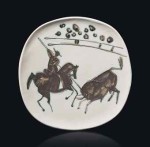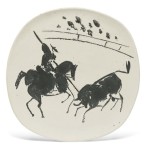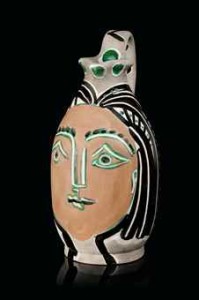Unique Picasso Ceramics vs. Madoura Editions
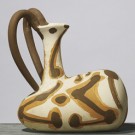
The market for Edition Picasso ceramics is hot. The auction prices of some pieces have soared 500% and more from one year (or one sale) to the next.
I’ve discussed the reasons for this explosion of interest before (the Runaway Bull, the Runaway Bull Returns, the High-Flying Owl), reminding people that the Edition Picasso Ceramics were not personally painted by Picasso. Though Picasso decorated over 4,000 ceramics, the Edition Picasso is comprised of some 600 “authentic replicas” recreated after Picasso’s unique prototypes by the artisans at the Madoura pottery in the South of France.
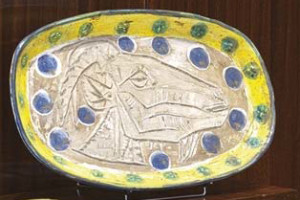
This Edition Picasso “Tête de chèvre de profil” AR 148 sold at Sotheby’s Paris on May 21, 2015, for $19,468.
When people hear about this distinction their initial reaction is often that they don’t want to buy “reproductions,” only originals. Unfortunately original Picasso paintings can cost as much as $179,365,000 at auction. A desirable Edition Picasso ceramic can sell for 1/10,000th of that (the Goat plate illustrated above brought only 1/9,213th of the record painting price, but you get the idea). No wonder these multiples quickly became collectable after their introduction in 1948 when they were sold as inexpensive souvenirs to vacationing tourists. That’s right, Edition Picasso ceramics purchased for fifty dollars in the 1950s are today worth tens of thousands.
So you would figure that the ceramics that Picasso personally decorated would be a lot more valuable than the ones that were replicated, right? Well, yes and no. Yes, they’re worth more. But no, they’re not worth 10,000 times more, or even 1000 times more. Or even 100 times more. Or, often, even 10 times more. And some of them have recently sold for less than Edition pieces.
One reason for this anomaly is the very rarity of Picasso’s “original” ceramics, most which were never commercially available. People equate rarity with value, but prices are determined in the marketplace. Picasso kept the vast majority of the unique pieces for himself and most ended up in museums or with members of the artist’s family. Consequently, the kind of competition that makes prices rise never developed for originals – they rarely came up for sale. However as early as the 1970s the approximately 120,000 ceramics in the Edition Picasso began appearing at auction. If a collector wanted an Edition Picasso ceramic there was a huge selection immediately available, but if he wanted a ceramic that Picasso himself had painted he might wait years before one appeared. The very term “Picasso ceramic” came to mean one of the multiples replicated by the artisans at Madoura.
It’s therefore doubly difficult to compare values for unique Picassos and Edition Picasso pieces, since not only do auction results swing wildly from place to place and year to year, there just isn’t much comparable sales data. Because of a rare coincidence, however, we now have a unique opportunity to make such price comparisons. In London on June 25, 2015, Sotheby’s sold a collection owned by Marina Picasso of over 100 ceramics personally painted by her grandfather (Marina is the daughter of Picasso’s son Paulo and his first wife, Olga Khokhlova). On the same day in another part of town there was a dedicated sale of Edition Picasso ceramics – at Christie’s South Kensington, the venue that has accounted for many of the recent record-breaking sale prices.
While comparing apples and oranges is still easier than comparing most of the ceramics in these two sales, some pieces are directly equatable. For instance, take a look at these two pieces:
The one on the left is from the Edition Picasso, Picador et taureau, AR 194, from the edition of 200 (the “AR” number is from Alain Ramié’s definitive catalogue raisonné). The one on the right was entitled Tauromachie in Marina Picasso’s collection, a unique ceramic hand-painted by Picasso — almost certainly the prototype for the Edition piece.
The AR 194 Edition Picasso Picador et taureau plate brought the equivalent of about $10,780 at Christie’s South Kensington. At the Sotheby’s sale across town the comparable unique piece sold for the equivalent of $68,800. Granted that neither one of these ceramics is a great work of art. In fact if you had been at Madoura in 1953 the Edition piece was probably one of the Picasso tsotchkes priced at five or ten bucks. But if you use these two ceramics as a guide, a Picasso “original” is worth 6.38 times more than the Edition Picasso piece.
However, another pair of ceramics tell a different story:
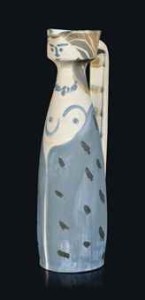
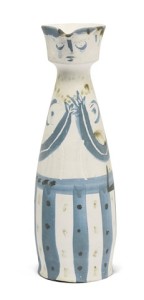 In the Christie’s sale, the AR 296 Edition Picasso ceramic, pictured on the left, sold for $27,440 (I’m using the auction houses’ conversions to translate all of these prices from pounds to dollars). The one of the right, one of Marina Picasso’s unique pieces, sold for $94,354 at Sotheby’s. The market — as well as your eyeballs — might suggest that these ceramics are “better” than the Picador plates. However, using these vases as a guide, a Picasso “original” is worth only 3.43 times more than the copy. Why does a “better” original bring a smaller multiple?
In the Christie’s sale, the AR 296 Edition Picasso ceramic, pictured on the left, sold for $27,440 (I’m using the auction houses’ conversions to translate all of these prices from pounds to dollars). The one of the right, one of Marina Picasso’s unique pieces, sold for $94,354 at Sotheby’s. The market — as well as your eyeballs — might suggest that these ceramics are “better” than the Picador plates. However, using these vases as a guide, a Picasso “original” is worth only 3.43 times more than the copy. Why does a “better” original bring a smaller multiple?
The most expensive piece in Sotheby’s sale of Marina Picasso’s ceramics, by far, was described as a vase but seems more of a sculpture than the usual shapes and plates in the Edition Picasso. It sold for $762,698 and is pictured at the top of this page. No Edition Picasso ceramic is even remotely comparable to this piece. The top lot in the Christie’s sale was Femme du Barbu (the Bearded Man’s Wife), AR 193, which sold for $163,856. Using these two ceramics as a guide you might conclude that the best Picasso original is worth 4.65 times more than the best Edition Picasso multiple.
Of course it is worth noting that Femme du Barbu is hardly among the “best” Edition Picasso ceramics. For starters it’s an edition of 500, the largest edition size made. I’ve found 16 other sales of this ceramic since 2013 with an average sale price of about $30,000 (until the Madoura sale in 2012 they brought much less). Femme du Barbu was estimated in the Christie’s catalogue for about $19,000 – $28,000. In short, it’s a fairly large, very common ceramic, and it’s whimsical and fun. But you can say the same about many, many other pieces.
So in the interest of fairness let’s look at what actually is considered to be the “best” Edition Picasso ceramic because of its scale, rarity, beauty and renown: the Grand Vase, AR 116. This ceramic is over ten inches larger than Femme du Barbu, it’s from an edition of just 25 (the smallest produced), it is pictured on the cover of the Alain Ramié’s catalogue raisonné and in a famous photograph of Picasso by Henri Cartier-Bresson. One of these pieces made the auction record for an Edition Picasso ceramic: $1,144,268 at the much hyped “Madoura” sale in 2012. Another brought $1,080,221 in 2014. Thus using the Grand Vase as a guide, the best “original” Picasso ceramic in Marina Picasso’s collection was worth less than the best Edition Picasso piece!
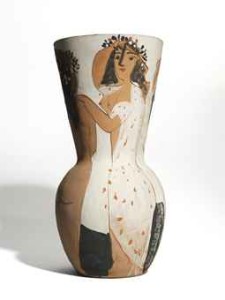
Prototype for Picasso “Grand Vase” AR 116 which brought a record $1.5 million. One of the 25 Madoura Edition Picasso copies brought $1.14 million.
If you want to get picky, at $762,698 Marina Picasso’s unique vase pictured above isn’t the “best” unique Picasso ceramic ever to sell at auction, at least in terms of price. Ironically that honor belongs to Picasso’s prototype for the same Grand Vase that set the record for most expensive Edition Picasso ceramic. This prototype sold in 2013 at Christie’s in London for $1,534,557. In other words, the original sold for only 1.5 times more than the copy.
Clearly something is screwy here. Either Edition Picasso ceramics are overpriced, unique Picasso ceramics are underpriced, or a combination of both. To say nothing of the possibility that the entire art market may presently be in the same kind of mania that precedes stock market crashes (and the fact that it’s silly to try to draw conclusions from individual sales in thinly traded, inefficient markets).
Regardless of whether an entire market is elevated or depressed, however, certain ratios should be constant unless there is a fundamental paradigm shift as there was in the 1970s and 1980s due to the influx of Japanese buyers. In Western culture, oil painting is the most important fine art; ceramics are less important. In Asia it’s just the opposite. When the Japanese entered the market, they were willing to pay vastly higher prices for ceramics than anyone ever had before. When they stopped buying at the beginning of the 1990s, prices crashed.
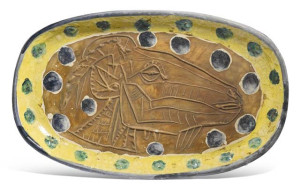
Unique Picasso Goat plate from Marina Picasso’s collection sold at Sotheby’s in June 2015 for $176,914
Let’s return for a moment to that $179 million record-price Picasso painting, and the fact that you can get a fine Edition Picasso ceramic for about 1/10,000th of that. The Tête de chèvre (AR 148) platter from the edition of 100 pictured at the top of this page is an example of such a bargain at a sale price of $19,468. If you believe in numerology (and the metric system) you’ll be interested to learn that Picasso’s probable prototype for Tête de chèvre sold for $176,914 in the Marina Picasso sale at Sotheby’s, about ten times more than its Edition Picasso equivalent but close to 1/1,000th of the record-price Picasso painting.
So, how much more should unique Picasso ceramics be worth than comparable Edition Picasso pieces? If the answer is 1000 times, then the Grand Vase prototype should have brought at least a BILLION dollars — 1,000 times the $1+ million that the two Edition Picasso Grand Vases have recently sold for. If the answer is 100 times, then the best originals should be somewhere between $50 and $100 million — 100 times the $500,000+ prices that many other Edition Picasso Grand Vases have brought at auction. If it’s a mere 10 times, as the the two 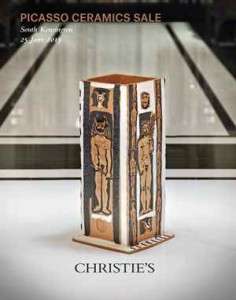 Goat plates would seem to suggest, then best original Picasso ceramics should sell in the $10,000,000 range. If the other examples compared above are better guides, then the best unique pieces should be $6,380,000 or $3,430,000, 0r $4,650,000 — in all cases significantly more than they have actually been selling for. To my mind the buyer of the beautiful Picasso at the top of the page got a steal.
Goat plates would seem to suggest, then best original Picasso ceramics should sell in the $10,000,000 range. If the other examples compared above are better guides, then the best unique pieces should be $6,380,000 or $3,430,000, 0r $4,650,000 — in all cases significantly more than they have actually been selling for. To my mind the buyer of the beautiful Picasso at the top of the page got a steal.
Clearly Christie’s believed that the “best” Edition Picasso ceramic in their sale of June 25, 2015, was Personnages et Têtes AR 242. At 22 inches tall, not only was it the largest piece in the sale, it was one of only 25, the smallest edition size produced at Madoura. It was pictured on the cover of the catalogue and brought the second highest price in the sale (after the outlier Femme du Barbu ), selling for $145,040 — over twice its low estimate ($62 ,000 – $92,000). Yet more than half of the unique Picasso ceramics from Marina Picasso’s collection at Sotheby’s sold for less than the cost of this Edition Picasso multiple. Granted that the originals were smaller in size and arguably less interesting than Personnages et Têtes, but they were actually from the artist’s hand, not “authentic replicas.”
Which would you rather own?


